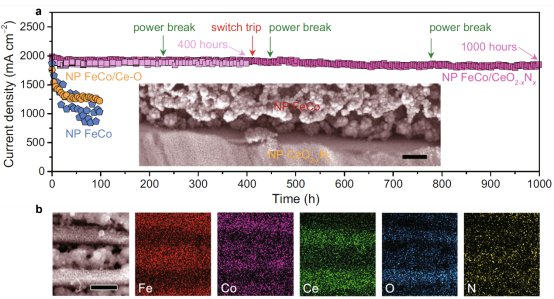Nature Communications from Jilin University-Qing Jiang and Jilin University-Xingyou Lang:Lamella-heterostructured nanoporous bimetallic iron-cobalt alloy/oxyhydroxide and cerium oxynitride electrodes as stable catalysts for oxygen evolution
Recently, Professor Qing Jiang and Professor Xingyou Lang from the School of Materials Science and Engineering at Jilin University have made new progress in the field of electrocatalytic water splitting to produce hydrogen. The research results are titled as " Lamella-heterostructured nanoporous bimetallic iron-cobalt alloy/oxyhydroxide and cerium oxynitride electrodes as stable catalysts for oxygen evolution " and were published online in Nature Communications at March 31, 2023.
Electrochemical water splitting powered by renewable electricity from plentiful solar and wind resources is an attractive energy conversion technology for clean and large-scale hydrogen production. However, water electrolysis no matter in alkaline water electrolyzers or proton-exchange-membrane water electrolyzers persistently undergoes a low energy efficiency primarily due to sluggish kinetics of oxygen evolution reaction (OER) and insufficient activity of state-of-the-art OER electrocatalysts. This dilemma persecutes widespread implementation of electrochemical water-splitting technologies, especially for mass production of H2 in industry, where they are required to deliver high current densities of >500 mA cm−2 at a low overpotential of <300 mV over thousands of hours. In this regard, it is of high desire to develop highly active, robust, and cost-effective OER electrocatalytic materials for highly efficient practical industrial electrolyzers.

Figure 1. Microstructure and electrochemical properties of nanoporous FeCo/CeO2−xNx electrode.
To address this issue, this work reports self-supported laminate composite electrodes of alternating hierarchical nanoporous bimetallic iron-cobalt alloy/oxyhydroxide and cerium oxynitride (FeCo/CeO2−xNx) heterolamellas as highly efficient and robust alkaline OER electrocatalytic materials. The composition of FeCo phase and CeO2−xNx phase, as well as the FeCo/CeO2−xNx interface are proved by conducting various characterization, such as SEM images, TEM images and EDS elemental mapping images.

Figure 2. Stability of nanoporous FeCo/ CeO2−xNx electrode.
As a consequence of heterolamellas offering abundant electroactive sites and three-dimensional bicontinuous nanoporous architecture facilitating electron transfer and mass transport, the nanoporous FeCo/CeO2−xNx electrodes exhibit superior alkaline OER electrocatalysis in 1 M KOH solution, with low onset overpotential (~186 mV) and Tafel slope (~33 mV dec−1). The OER current density achieves to ~1195 mA cm−2 at the low overpotential of 300 mV, which is twice of the industrial requirement. While extending the overpotential to 360 mV, they can reach an ultrahigh current density of >3900 mA cm−2. Moreover, the nanoporous FeCo/CeO2−xNx electrodes show exceptional stability for more than 1000 h at the current density of ~1900 mA cm−2. These impressive electrochemical properties outperform commercially available RuO2 and some representative OER catalysts.
Shupei Zeng, Hang Shi and Tianyi Dai are the co-first authors of this paper. Corresponding authors are Professor Qing Jiang and Professor Xingyou Lang, from School of Materials Science and Engineering at Jilin University. This work was supported by the National Natural Science Foundation of China.
Full article link: https://doi.org/10.1038/s41467-023-37597-4